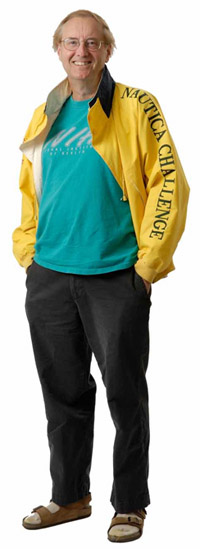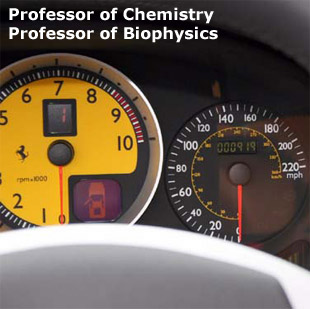
Eric Oldfield, PhD |
||
 |
||

|
||
|
A110 Chemical & Life Sciences Laboratory |
||
|
BSc PhD DSc FAIC FAPS CChem FRSC |
||
|
Education: Awards and Fellowships: Positions Held: Teaching: Committees, etc.: Consultancies: Society Memberships: Research background and InterestsI was educated in London, Bristol and Sheffield, then moved to the US as a European Molecular Biology Organization Fellow at Indiana University with Adam Allerhand and a Visiting Scientist at MIT with John Waugh. I am currently a Professor of Chemistry and a Professor of Biophysics. At Sheffield, we developed the deuterium NMR method to investigate the structures of liquid crystals and biological membranes. We synthesized specifically 2H-labeled phospholipids and were able to show that 2H NMR quadrupole splittings were an important new probe of lipid bilayer structure, and that sterols such as cholesterol caused large increases in hydrocarbon chain order parameters. At Illinois, we then showed that specific 2H-labeling of lipid headgroups enabled a detailed picture of headgroup conformation to be obtained, and the general success of the deuterium NMR method for investigating liquid crystal and membrane structure can be seen from its use by many groups worldwide, where order parameters from 2H spectra give the most detailed view of membrane order and dynamics available so far. Together with A. Allerhand, we developed novel, high sensitivity Fourier transfer NMR instrumentation and observed the first carbon-13 NMR spectra of proteins, which began to open up new areas of research by demonstrating that carbon-13 spectra of proteins could be extremely highly resolved, and carbon-13 NMR of proteins in solution is now considered a routine technique to obtain static and dynamic information about the structure of macromolecules in solution. We then began to develop new ways of obtaining high resolution solid state NMR spectra of inorganic and biological systems. We showed that high-resolution NMR spectra of quadrupolar nuclei in inorganic solids could often be obtained by observing the so-called central (1/2 -1/2) transition, which is only broadened to second-order by the quadrupole interaction. At high magnetic fields, the effect is small, and we demonstrated that it could be further reduced by spinning at unusual angles in the magnetic field - the variable-angle sample spinning approach. We then pursued the use of oxygen-17 NMR in investigating inorganic solids such as silicates and zeolites, where we found that accurate chemical shifts, quadrupole coupling constants and asymmetry parameters could all be obtained, and interpreted in detailed structural terms. This work was then extended into the realm of solid-state physics via investigations of relaxation processes in oxides and high-temperature superconductors, then into the biological area via studies of oxygen-17 labelled oxygen and carbon monoxide bonding to proteins, such as hemoglobin. We also showed that exceptionally well resolved carbon and proton spectra of lipid bilayers could be obtained, by using high field "magic-angle" sample spinning techniques. Our results provided greatly enhanced resolution over obtained using sonicated bilayers, due in large part to the inhomogeneous nature of the dipolar interactions, and the lack of linebroadening due to vesicle tumbling, opening up new ways to investigate membrane structure. We subsequently began to work on solving the chemical shift problem in proteins, identified earlier - how does folding a protein into its native conformation generate very large chemical shift nonequivalencies? In the early 1990's, we began to use ab initio and density functional quantum chemical methods (typically used by theorists to study much smaller molecules) to try to compute the chemical shifts of carbon-13 and nitrogen-15 nuclei in proteins. It worked, and we demonstrated that it is possible to accurately predict chemical shifts of C-13, N-15 and F-19 nuclei in proteins, work that is adding a "new dimension" to protein structure studies, as well as solving a long-standing spectroscopic problem. Moreover, our most recent results show that accurate backbone and sidechain structural (torsion angle) parameters can be obtained from chemical shifts, and that protein structures can begin to be refined by using such chemical shift information. This work was then extended to investigating metal-ligand bonding in heme proteins, where we combined solid state NMR, solution NMR, Mössbauer and infrared spectroscopy and quantum chemistry to investigate in detail how small molecules, such as oxygen and carbon monoxide, bind to heme proteins, such as hemoglobin and myoglobin. The problem of how CO and oxygen are discriminated in their binding has been a topic of lively debate for over 20 years, with early crystallographic studies indicating CO binds in a "bent" manner, which is destabilizing, this being the textbook model of CO/oxygen discrimination. However, by using density functional theory to analyze C-13, O-17 and Fe-57 NMR chemical shifts, 57Fe Mössbauer quadrupole splittings and infra-red spectroscopic results, we were able to demonstrate that CO binds in a close-to-linear and untilted fashion to hemoglobin and myoglobin. This strongly supports the idea that it is the stabilization of oxygen binding (via hydrogen bonding) rather than CO-destabilization, which is the origin of CO/oxygen discrimination. In addition to these studies of metal-CO interactions in biological systems, we have also made extensive investigations in collaboration with A. Wieckowski, into the topic of how CO binds to metals in heterogeneous catalysts, in particular those used in fuel cells. We have shown that by using high field NMR it is possible to readily investigate both the metal sites (via Pt-195 NMR) and the ligands (via C-13 NMR), and that there is a clear relationship between the Knight shift of the CO molecules bound to the catalyst surfaces and the electronic local density of states at the Fermi level of the Pt catalysts, which opens up exciting new possibilities of using NMR to probe the electronic properties of many other heterogeneous catalysts. In recent work, carried out in collaboration with the groups of J. Urbina, R. Docampo and S. Croft, we have branched out into yet another new area, molecular parasitology. We first found evidence for extremely large levels of inorganic di- and triphosphate in the protozoa which cause African sleeping sickness and malaria. This then led us to the idea that it might be possible to kill these and other related parasites by using stable diphosphate analog drugs to block specific metabolic pathways, and this indeed was found to be the case. The drugs used, called bisphosphonates, have been used to treat bone-resorption diseases for over 20 years, but their mode of action had been unknown. However, in recent work, we have shown that the most potent, nitrogen-containing bisphosphonates used in treating bone diseases are also potent drugs in killing parasites, and act to perturb protein prenylation and signaling by inhibiting the enzyme farnesyl pyrophosphate synthase. Using quantum chemistry and molecular modeling, we showed that the charged ammonium side-chains in the drugs act as carbocation transition state analogs, and bind into the active site of the enzyme, blocking its action. This gives a sound molecular basis for drug design, based on known protein structures and mechanisms of drug action, and is a topic of considerable current interest. And finally, in our most recent work we have found that it is possible to apply the computational methods used in modern drug design and drug discovery to the immune system where we are employing QSAR (quantitative structure activity relationships) to probe innate immunity. In particular, we are interested in the development of drugs which activate γδ T cells, opening the way to new therapies for infectious diseases, cancer, and vaccine development. |
||
(c) 2010-2015 Research Group of Professor Eric Oldfield
University of Illinois at Urbana-Champaign
For website issues or concerns, contact our
webmaster